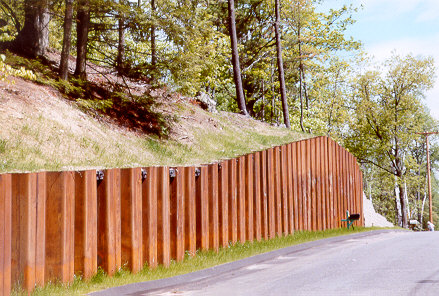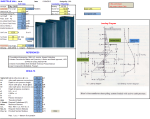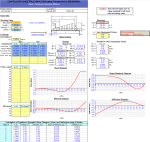SHEET PILE using BEAMANAL

Description
This spreadsheet calculates the capacity of a cantilever sheet pile in English units and using common US sheeting sections. The geotechnical worksheet computes earth pressures and embedment. The Structural worksheet uses BEAMANAL spreadsheet by Alex Tomanovich, P.E. and the geotechnical analsyis worksheet to compute stresses and deflections.
Calculation Reference
Foundation Engineering Jumikis
Modern Formulas for Statics and Dynamics A Stress-and-Strain Approach Pilkey & Chang McGraw Hill
Skyline (ArcelorMittal) Steel Sheetpile Technical Product Manual
The capacity of a cantilever sheet pile refers to its ability to retain soil and resist lateral earth pressure without additional support. Cantilever sheet piles are commonly used in relatively shallow excavations or when temporary support is required. The design of a cantilever sheet pile involves determining the required penetration depth and ensuring stability against various failure modes.
Here's an outline of the process for determining the capacity of a cantilever sheet pile:
-
Gather necessary information: Collect site-specific information, such as soil properties, groundwater conditions, surcharge loads, and applicable design standards.
-
Define sheet pile geometry: Establish the type, material, and dimensions of the sheet pile based on the site requirements and constraints.
-
Calculate earth pressures: Determine the lateral earth pressure acting on the sheet pile due to the retained soil, groundwater, and surcharge loads. Use appropriate earth pressure theories (e.g., Rankine or Coulomb) to calculate active and passive earth pressures.
-
Determine the required penetration depth: The penetration depth is the portion of the sheet pile that extends below the excavation level. It should be deep enough to ensure stability against various failure modes, such as rotation, sliding, and bearing capacity failure. Calculate the required penetration depth by analyzing the equilibrium of forces and moments on the sheet pile, and ensure that the factor of safety against each failure mode meets the minimum requirements specified in the design codes.
-
Check structural capacity: Assess the structural capacity of the sheet pile to resist the bending moments and shear forces induced by the lateral earth pressure. Use appropriate design methods, such as the AASHTO LRFD Bridge Design Specifications or Eurocode 3, to determine the required section modulus and moment of inertia of the sheet pile.
-
Check for deflection and vibrations: Ensure that the maximum deflection and vibrations of the sheet pile are within acceptable limits as specified in the design codes or project requirements.
-
Check for global stability: Analyze the global stability of the cantilever sheet pile system, considering the potential for deep-seated slope failures or other modes of instability.
The design of a cantilever sheet pile is a complex process that requires a thorough understanding of soil mechanics, structural engineering, and applicable design codes. It is always recommended to consult with experienced geotechnical and structural engineers to ensure a safe and efficient sheet pile design.
Calculation Preview
Full download access to any calculation is available to users with a paid or awarded subscription (XLC Pro).
Subscriptions are free to contributors to the site, alternatively they can be purchased.
Click here for information on subscriptions.



